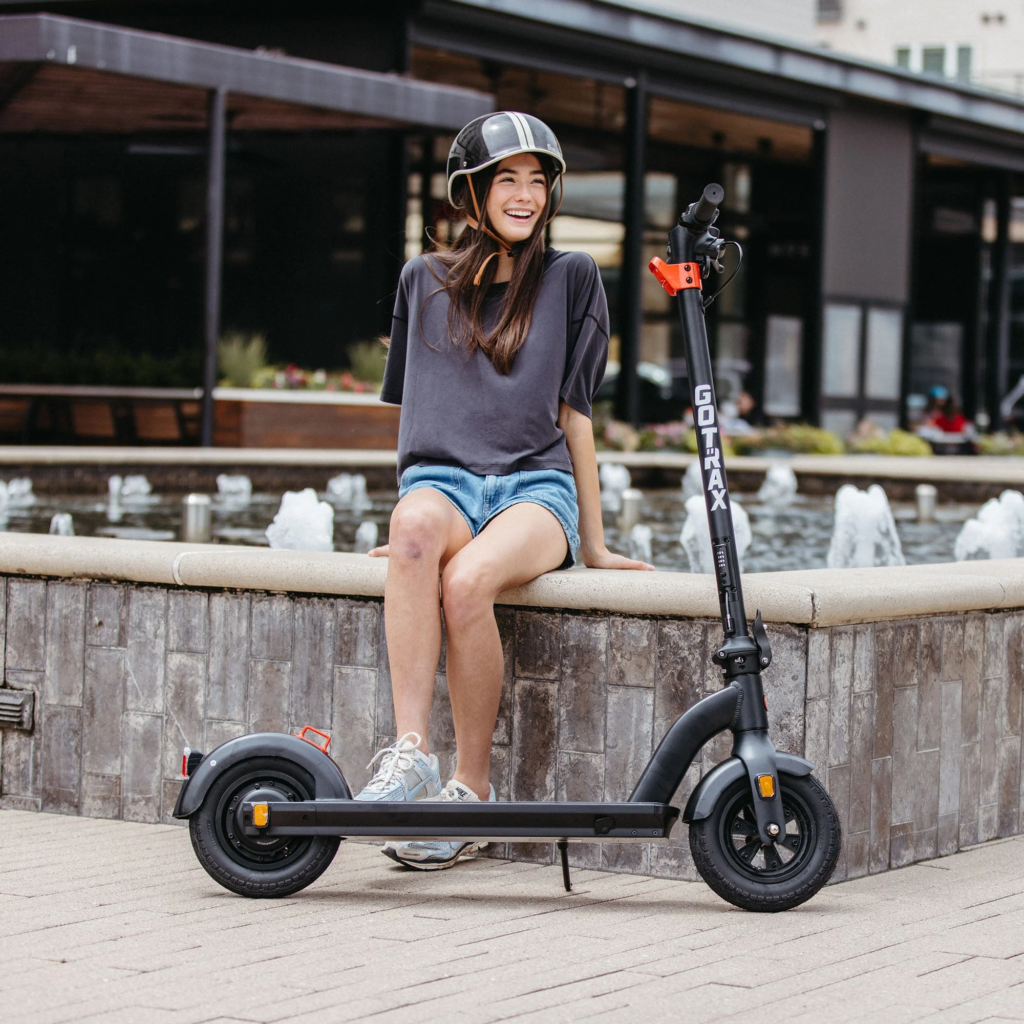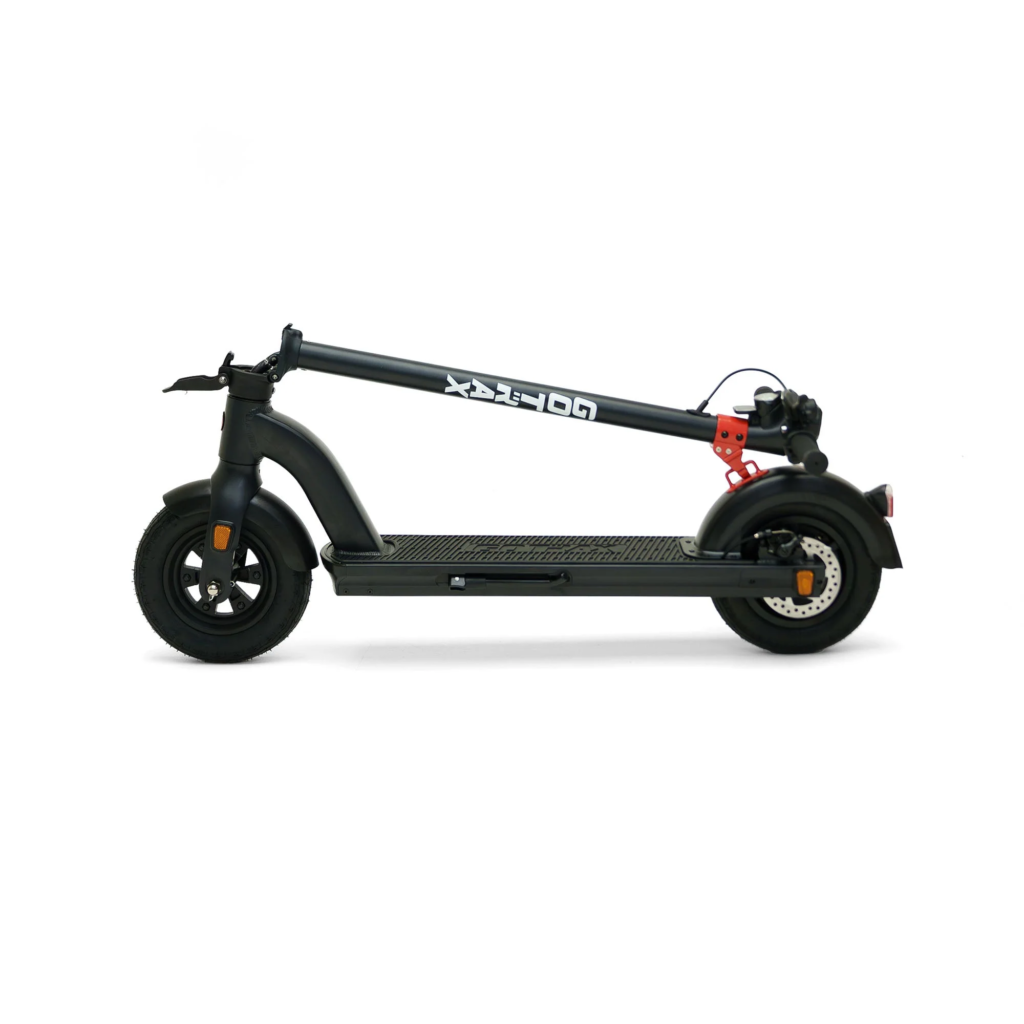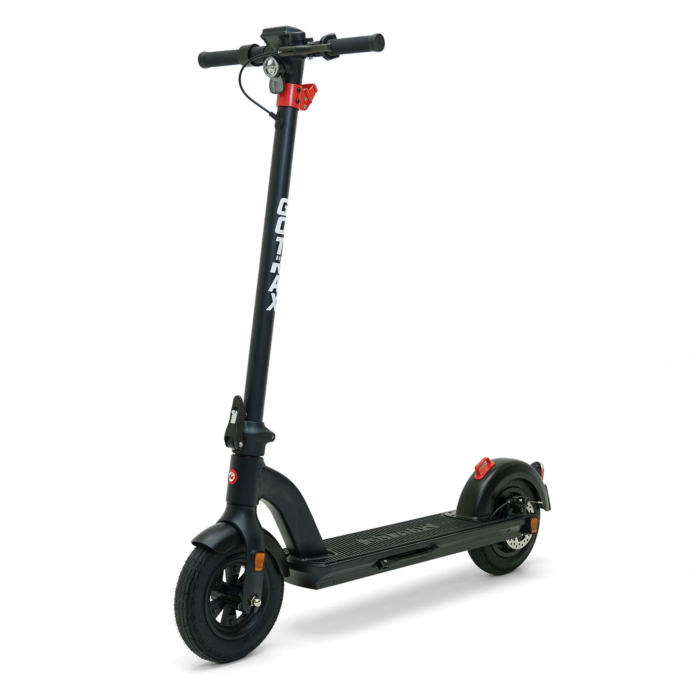Quick Take
If you want an everyday electric scooter that favors real range over flashy top speed, the GoTrax G3 Max is a smart buy. It pairs a 48V battery, a 350W rear hub motor, and 10-inch pneumatic tires with a simple fold and a commuter-friendly cockpit. On paper, the scooter is built for long urban rides and reliable week-to-week use. In practice, it’s a steady, predictable machine that shines on bike lanes and neighborhood streets. For full specifications and a tidy spec sheet, see GoTrax G3 Max — Specs & Details.
Key Specs (At a Glance)
- Motor: 350W rear hub
- Top Speed: ~17 mph
- Battery: 48V class, ~10 Ah capacity
- Claimed Range: up to ~37 miles (ideal conditions)
- Tires: 10″ pneumatic (air-filled)
- Brakes: Mechanical plus electronic assist (class-typical)
- Frame & Fold: One-touch style, commuter-oriented
- Rider Weight Limit: Up to ~264 lb
- Charger: ~54.6V / 2A typical for this class
- Certifications & Safety: Modern e-mobility safety standards; basic splash resistance
As always, specs can vary slightly between production runs; therefore, confirm the printed spec on your unit.
Design and Build: Practical First, Flashy Second
The G3 Max embraces a function-over-frills approach. Consequently, your first day of ownership is easy. The deck is long enough for a comfortable stance, and the folding mechanism is quick; therefore, you can transition from riding to carrying without fuss. Because the latch is intuitive, you won’t fight it during a transit connection or at an office door.
Moreover, the frame feels stable at commuting speeds. The scooter tracks straight, and the 10-inch tires help it shrug off cracks and seams. Meanwhile, the LED display shows speed, battery, and trip basics. The buttons are simple, tactile, and easy to learn. Additionally, you get an integrated headlight for dusk rides, which increases visibility when traffic picks up.
Overall, the finish sits above what you’d expect in the entry-to-mid price band. Welds look tidy and panels sit flush. Furthermore, cable routing stays out of the way. You will still notice a few cost-saving choices; however, the big pieces that matter—deck, stem, latch, and tire size—are exactly where commuters benefit most.
Performance: Not a Sprinter, Absolutely a Stayer
Speed You Can Use
Top speed lands around 17 mph. Admittedly, that won’t wow speed chasers. Even so, it feels right on bike lanes and shared paths where 12–18 mph is the norm. Because the scooter holds a steady pace without drama, you build confidence quickly. Thus, routine trips become easy.
Acceleration That’s Predictable
The 350W motor launches with a smooth ramp rather than a kick. As a result, new riders appreciate the calm start. Experienced riders may wish for extra punch off the line; nevertheless, the payoff is efficiency and battery life. In traffic, you’ll still clear intersections cleanly—especially if you anticipate lights and keep a light finger on the brake.
Hill Behavior
On short, mild inclines, the G3 Max keeps momentum. On longer or steeper climbs, speed fades as the motor nears its limits. Therefore, plan to downshift your expectations on 8–12% grades. That said, gentle rolling terrain is fine. If your commute includes long hills every day and you want 20+ mph uphill, you’re shopping a different class.

Range: Realistic Expectations and How to Hit Them
Manufacturers cite “up to” range numbers based on light riders, slower modes, flat terrain, and ideal weather. The G3 Max’s claim reaches the high-30-mile mark. Realistically, plan on 15–25 miles at moderate speeds for average riders on mixed city terrain; lighter riders who cruise steadily can stretch farther.
To get the most from the pack, consider these habits:
- Ride one mode lower when you aren’t rushing; consequently, you’ll save watts.
- Keep tires at proper PSI. Underinflation robs range and ride quality.
- Ease into the throttle. Smooth takeoffs beat jackrabbit starts; moreover, they reduce heat in the motor.
- Carry speed smartly. Roll toward lights instead of surging and braking; as a result, you conserve battery.
- Top up at work if your round-trip hovers near your limit; even a short charge helps.
Because the pack runs at 48V, the scooter keeps usable pace deeper into the battery than many 36V commuters. Eventually, as voltage sags, you’ll feel the controller ease power to protect the pack. This behavior is normal; therefore, plan charging accordingly so you’re never stranded.
Ride Quality: Big Tires Do the Heavy Lifting
Entry-to-mid commuters often skip suspension to keep weight and cost down; the G3 Max follows suit. Instead, it relies on 10-inch air-filled tires to soak up chatter. Accordingly, on patchy city streets, those tires are the difference between teeth-chatter and tolerable buzz. You’ll still feel potholes, of course. However, the combination of tire volume, moderate speed, and a stable deck delivers a ride that’s surprisingly forgiving for this price class.
Set tire pressure with care. Too low, and the scooter feels sluggish while pinch-flat risk rises. Too high, and more vibration reaches your hands and knees. Consequently, you should find a sweet spot within the recommended range for your weight and terrain. Recheck weekly; air seeps out over time.
Braking: Confidence Comes from Setup and Practice
Commuter scooters in this segment commonly blend a mechanical brake (lever-actuated) with electronic motor braking. The G3 Max follows that formula. Out of the box, lever feel can vary; therefore, plan a quick tune-up after your shakedown ride. Seat the cable, check pad alignment, and ensure the rotor is clean. A well-set mechanical brake feels predictable and strong at urban speeds.
Next, learn your stopping distance in a safe lot. Do several progressive stops from different speeds. As a result, you’ll build muscle memory and a clear sense of grip. In rain, slow down earlier, ride smoother lines, and double your space. Notably, rubber and paint never mix well; avoid lane markings and metal plates when wet.
Battery and Charging: Daily Rhythm Matters
The pack’s 48V architecture and roughly 10-amp-hour capacity define how the scooter behaves. Voltage supports usable speed, while capacity provides commuting legs. The included ~2A charger is typical; consequently, a full charge from low takes several hours. Thus, charge overnight or top up at your desk if you ride daily.
You’ll extend pack life with a few good habits:
- Avoid deep discharges when possible; in fact, partial cycles are easier on cells.
- Store at room temperature and keep the charge port dry; moisture accelerates corrosion.
- Charge to full before long weekend rides; conversely, day-to-day, 80–90% is fine.
- Let the pack rest a few minutes after a ride before plugging in; consequently, heat stabilizes.
Safety, Water Resistance, and Night Riding
Modern adult e-scooters follow strict electrical safety standards; the G3 Max is no exception. As for water, assume splash resistance, not waterproofing. Light drizzle and damp streets are manageable with caution; however, heavy rain, deep puddles, or pressure washing are not. After a wet ride, dry the deck and charge port before plugging in; otherwise, you risk long-term damage.
The stock headlight helps, but night riders should think in layers. Therefore, add a brighter handlebar light for beam throw and an extra rear flasher on your backpack or belt. Redundancy makes you more visible at angles where a single headlight can get lost in the visual noise of traffic.
Portability and Weight: Manageable but Not Ultra-Light
Battery capacity brings weight. Expect the G3 Max to sit in the low-40-pound bracket. Consequently, it’s fine for a flight of stairs or a quick hop onto transit, but it isn’t the featherweight you shoulder all day. The fold, however, is compact and secure; thus, the scooter tucks into a corner of your office or apartment without dominating the space. For car trunks, it’s a simple in-and-out thanks to a balanced carry point near the stem.
If you must carry it often, consider a stair grip or soft strap. These small quality-of-life upgrades protect your hands and jacket; moreover, they make repetitive carries safer.

Controls, Display, and App-Free Ease
The G3 Max favors no-nonsense controls. Power, mode, and light—that’s the trio you’ll use most. The display is legible in daylight and clear after sundown. Because the interface is simple, there’s little to distract you while riding. Therefore, you don’t need an app to change basic settings or unlock top speed. That will appeal to riders who prefer set-and-forget hardware.
Security: Think Layers, Not Just One Lock
The integrated tiller lock is a useful deterrent for quick stops. Nevertheless, any lock that’s part of the scooter has limits. In cities, supplement it with a U-lock or chain threaded through a sturdy anchor. If you must leave the scooter out of sight for hours, add a hidden tracker in the stem or deck. Additionally, photograph your serial number and keep your receipt. While recovery is never guaranteed, layered security and documentation improve your odds.
Warranty and Customer Support: What to Expect
Mainstream commuter scooters now carry straightforward warranty coverage with specific exclusions for wear parts. With the G3 Max, expect coverage on electronics and frame for a defined term, plus standard support channels for troubleshooting and parts. Consequently, keeping your serial number and order info handy speeds up any claim. Clear photos and a concise description of the issue help as well.
Who the GoTrax G3 Max Suits Best
Choose the G3 Max if you:
- Want real-world range in a sensible, sub-20-mph package.
- Ride mostly flat urban routes with occasional mild hills.
- Prefer 10″ pneumatic tires for comfort over undamped budget suspension.
- Value simple controls, easy folding, and a predictable ride.
Skip it if you:
- Need 25+ mph and strong hill surges daily; in that case, shop a higher tier.
- Demand dual suspension and hydraulic brakes for rough terrain.
- Intend to ride in heavy rain or leave the scooter outside overnight.
Real-World Impressions: The Commuter’s Angle
Owners often praise the quiet, steady ride and battery stamina when cruising at modest speeds. They also highlight how the bigger tires take the edge off expansion joints and cracks. Conversely, some riders note that top-end speed feels conservative. That’s fair—this scooter is built to stretch miles, not to slay sprints. Others mention weight: it’s carryable, yet not a feather. Those themes are consistent across the class and, importantly, they set realistic expectations for any long-range, 48V commuter under a thousand dollars.
Range Strategy: How to Hit 20–30 Miles More Often
- Plan your pace. Use lower modes on long straight sections; moreover, avoid unnecessary bursts.
- Respect wind and cold. Headwinds and winter temps cut range; therefore, budget extra.
- Keep tires healthy. Good PSI and fresh tubes reduce rolling losses.
- Avoid needless stops. Smooth traffic reading adds free miles; consequently, your battery lasts longer.
- Charge at work. A 60–90-minute top-off after lunch can add 6–10 miles.
Comparisons: Where the G3 Max Lands
- Versus smaller-battery commuters: The G3 Max’s 48V setup carries speed farther into the discharge curve; thus, you feel less slowdown late in the ride.
- Versus faster, sportier models: Speedier scooters hit 20–28 mph and climb better; however, they weigh more, cost more, and drain faster.
- Versus budget suspension scooters: Cheaper suspension often underwhelms; consequently, the G3 Max’s tire-first comfort can be the better everyday choice.
In short, the G3 Max is a range-centric value play. If speed thrills you, move up a tier. If daily miles matter more, stay right here.
Maintenance: 20-Minute Monthly Ritual
- Fastener check: Stem clamp, axle nuts, caliper mount, and rotor bolts; moreover, re-torque anything that settles.
- Brake tune: Confirm lever throw, pad wear, and rub-free rotation.
- Tire service: Inspect tread, check PSI, and remove embedded debris.
- Battery care: Note charge cycles, avoid deep drains, and store dry.
- Cleanliness: Wipe dust, purge grit around the latch, and keep connectors tidy.
These small tasks keep any commuter scooter feeling tight and reliable well past the first year.
Pros and Cons
Pros
- Excellent value for riders who prioritize range
- 48V battery keeps pace steady through the ride
- 10″ pneumatic tires boost comfort on imperfect streets
- Simple fold and cockpit; easy to live with daily
- Calm power delivery that suits new and returning riders
Cons
- ~17 mph top speed feels modest to speed seekers
- No suspension; you still steer around potholes
- Weight in the low-40s lb isn’t fun up many stairs
- Braking hardware is basic and benefits from careful setup
FAQs
Is the GoTrax G3 Max waterproof?
Treat it as splash-resistant. Light rain is manageable with caution; however, avoid heavy downpours and deep puddles. Dry the scooter before charging.
What range should I plan for?
Aim for 15–25 miles at moderate speeds on mixed terrain. Light riders, slow modes, and flatter routes can stretch beyond that; conversely, cold weather and hills cut range.
How fast does it go?
About 17 mph. That’s perfect for bike lanes and neighborhood streets. If you need more, choose a different tier.
What about rider weight?
The published limit is around 264 lb. Heavier riders should expect reduced range and hill speed; that’s normal for single-motor commuters.
Verdict
The GoTrax G3 Max delivers what many riders actually need: dependable range, a comfortable tire setup, and calm manners in real city traffic. It isn’t built to shatter top-speed charts, and that’s okay. Instead, it helps you stack reliable miles day after day without drama. If your commute lives in the 5–12-mile window and you want a scooter that just works, the G3 Max is a smart, budget-friendly choice that punches above its price where it counts.


